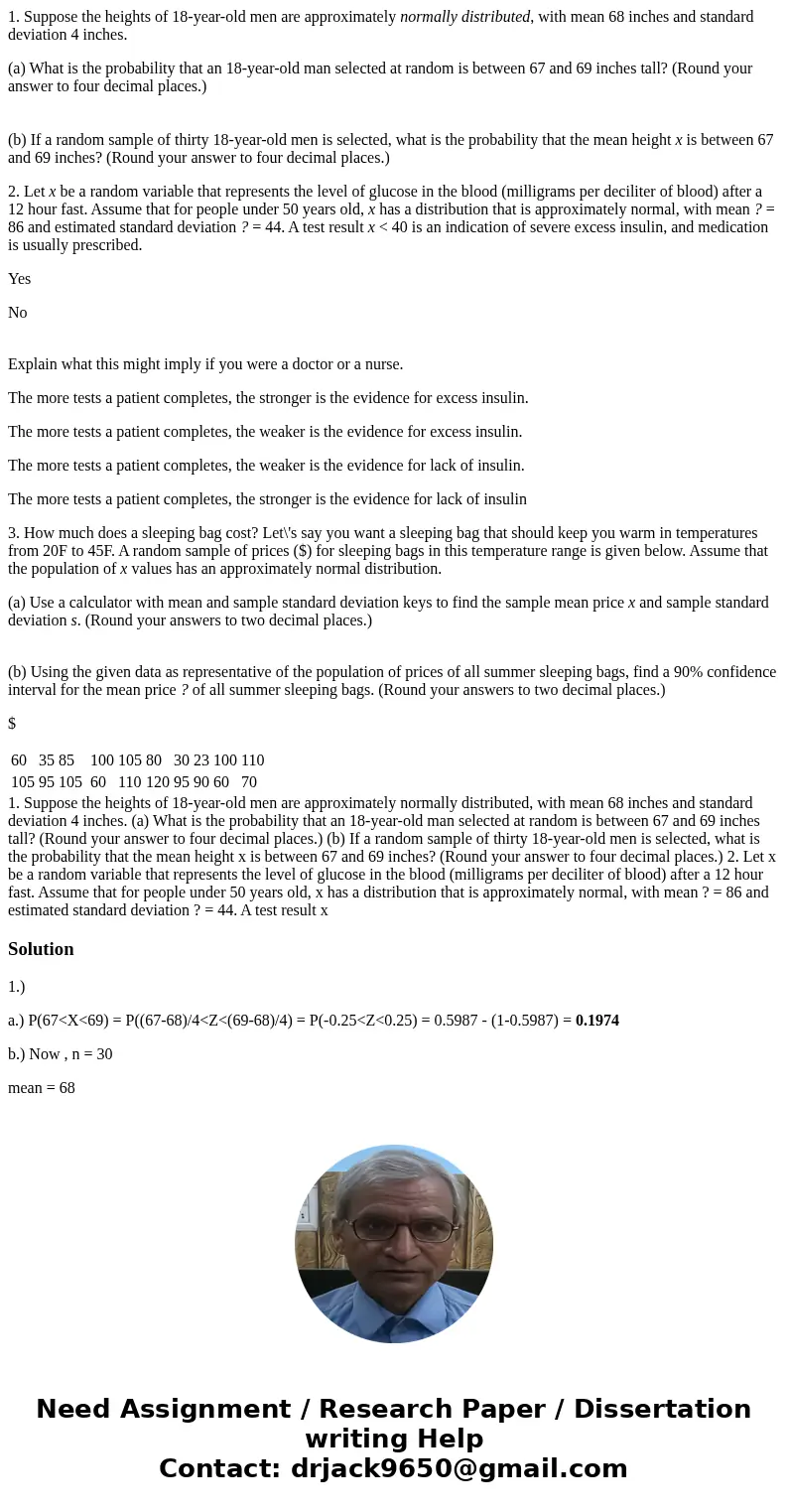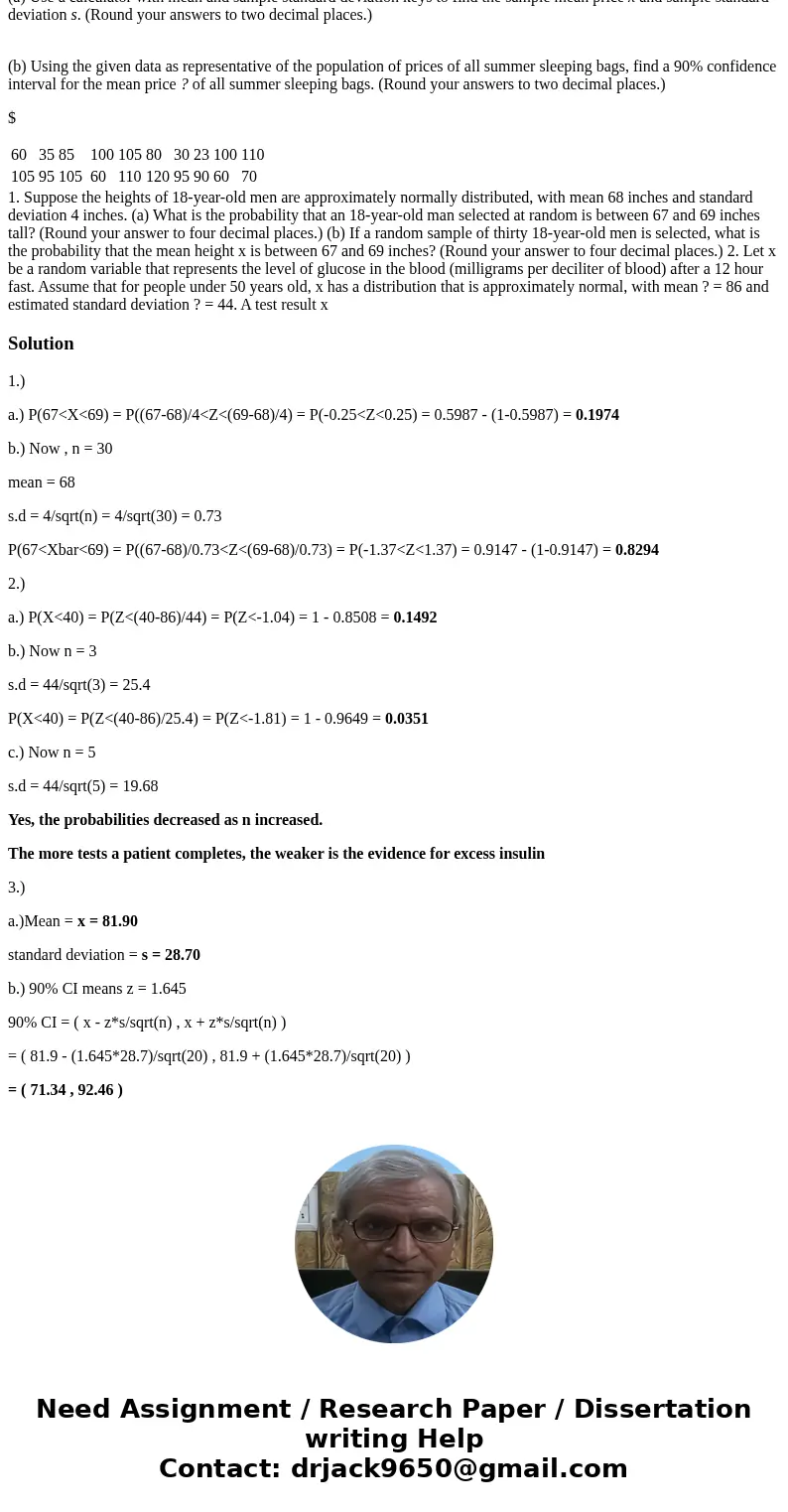1 Suppose the heights of 18yearold men are approximately nor
1. Suppose the heights of 18-year-old men are approximately normally distributed, with mean 68 inches and standard deviation 4 inches.
(a) What is the probability that an 18-year-old man selected at random is between 67 and 69 inches tall? (Round your answer to four decimal places.)
(b) If a random sample of thirty 18-year-old men is selected, what is the probability that the mean height x is between 67 and 69 inches? (Round your answer to four decimal places.)
2. Let x be a random variable that represents the level of glucose in the blood (milligrams per deciliter of blood) after a 12 hour fast. Assume that for people under 50 years old, x has a distribution that is approximately normal, with mean ? = 86 and estimated standard deviation ? = 44. A test result x < 40 is an indication of severe excess insulin, and medication is usually prescribed.
Yes
No
Explain what this might imply if you were a doctor or a nurse.
The more tests a patient completes, the stronger is the evidence for excess insulin.
The more tests a patient completes, the weaker is the evidence for excess insulin.
The more tests a patient completes, the weaker is the evidence for lack of insulin.
The more tests a patient completes, the stronger is the evidence for lack of insulin
3. How much does a sleeping bag cost? Let\'s say you want a sleeping bag that should keep you warm in temperatures from 20F to 45F. A random sample of prices ($) for sleeping bags in this temperature range is given below. Assume that the population of x values has an approximately normal distribution.
(a) Use a calculator with mean and sample standard deviation keys to find the sample mean price x and sample standard deviation s. (Round your answers to two decimal places.)
(b) Using the given data as representative of the population of prices of all summer sleeping bags, find a 90% confidence interval for the mean price ? of all summer sleeping bags. (Round your answers to two decimal places.)
$
| 60 | 35 | 85 | 100 | 105 | 80 | 30 | 23 | 100 | 110 |
| 105 | 95 | 105 | 60 | 110 | 120 | 95 | 90 | 60 | 70 |
Solution
1.)
a.) P(67<X<69) = P((67-68)/4<Z<(69-68)/4) = P(-0.25<Z<0.25) = 0.5987 - (1-0.5987) = 0.1974
b.) Now , n = 30
mean = 68
s.d = 4/sqrt(n) = 4/sqrt(30) = 0.73
P(67<Xbar<69) = P((67-68)/0.73<Z<(69-68)/0.73) = P(-1.37<Z<1.37) = 0.9147 - (1-0.9147) = 0.8294
2.)
a.) P(X<40) = P(Z<(40-86)/44) = P(Z<-1.04) = 1 - 0.8508 = 0.1492
b.) Now n = 3
s.d = 44/sqrt(3) = 25.4
P(X<40) = P(Z<(40-86)/25.4) = P(Z<-1.81) = 1 - 0.9649 = 0.0351
c.) Now n = 5
s.d = 44/sqrt(5) = 19.68
Yes, the probabilities decreased as n increased.
The more tests a patient completes, the weaker is the evidence for excess insulin
3.)
a.)Mean = x = 81.90
standard deviation = s = 28.70
b.) 90% CI means z = 1.645
90% CI = ( x - z*s/sqrt(n) , x + z*s/sqrt(n) )
= ( 81.9 - (1.645*28.7)/sqrt(20) , 81.9 + (1.645*28.7)/sqrt(20) )
= ( 71.34 , 92.46 )


 Homework Sourse
Homework Sourse